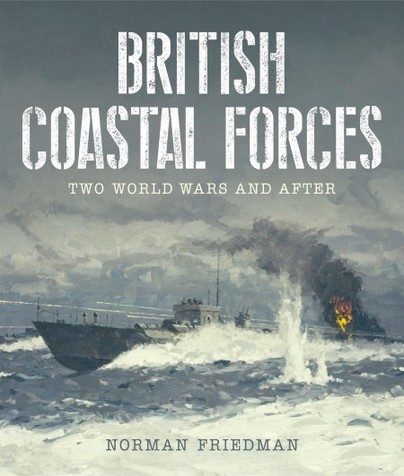
British Coastal Forces. Two World Wars and After. By Norman Friedman. Seaforth Publishing, Barnsley, 2023. ISBN 978-1-3990-1858-6
Reviewed by David Hobbs
Norman Friedman’s work needs little introduction to ANI members. He is a naval analyst of international repute who has written more than thirty major books in which his meticulous research of archival material and penetrating analysis stand out and has lectured extensively over many years.
His acknowledgements list a number of people and across the world who have provided him with images and material, among them Dr Josef Straczek of Australia. The book is available in both hardback and digital formats, the former is beautifully presented in Seaforth’s large format with 394 pages of text. It contains 220 black and white photographs and 77 three-view drawings of coastal forces vessels, many of which are previously unpublished. As well as motor torpedo boats, MTB, and motor gun boats, MGB, the author includes motor launches, ML, and harbour defence motor launches, HDML, in the text. The latter two types were operated by the RAN and apparently some consideration was given before 1939 to Australian procurement of MTBs which would have been built at the Cockatoo Island Dockyard but the proposal came to nothing.
The book is laid out logically beginning with a brief history of fast attack craft used by the RN from their origins until their withdrawal from operational service in the 1980s. The export market for light attack boats is described and Friedman ends this section by observing that a critic of the decision to abandon fast combat craft might point to the rise of Iranian swarm craft in the vitally important waters of the Gulf as an argument that such craft may figure in the RN of the future. The next chapter describes the builders responsible for designing and building fast attack craft used by the RN. The third describes what is meant by ‘fast’ and the technology that underpinned the design of a range of boats and their powerplants. The construction of coastal craft was an interestingly international affair. Many British boats had US Packard engines supplied under Lend/Lease arrangements and a significant number of boats were designed in the UK, built in the USA and shipped to the UK for use by the RN, again under Lend/Lease legislation.
Subsequent chapters follow with chronological descriptions of coastal forces and an Appendix describes the fast Air-Sea rescue launches operated by the RAF for comparison. The evolution of each type is carefully described in great detail making this the outstanding work to date on a type of warship that deserves to be better understood. Friedman does not give a blow-by-blow account of their activities but he does describe how operational experience and the opinions of officers who became expert in their use influenced design as the war progressed. That said the requirements to counter German E-boats and protect the UK east coast convoys are given the emphasis they deserve and the descriptions of both torpedoes and guns and the manner in which they were used in action is fascinating. A complete chapter is devoted to the important work of coastal forces during the amphibious landings in Normandy in June 1944. British-designed MLs and HDMLs served in large numbers in a variety of roles in many navies including both the RAN and USN both during World War II and after it.
After the main text there is a data list that fills five pages and allows the performance of the various classes to be compared at a glance. That is followed by a list of coastal forces boats that covers every vessel built from 1916 onwards, including MLs and HDMLs as well as MTBs, MGBs and steam gun boats, SGB. This comprehensive list includes the vessels that served with the RAN and RNZN as well as the RN and other navies. As one would expect the book has both bibliography and index
This is a very impressive work that is likely to remain the definitive work on the subject for the foreseeable future. Norman Friedman’s research and his analysis of the many tasks carried out by RN coastal forces over a period of seventy-five years are exemplary and this book adds significantly to his earlier ranges of books covering larger warship types in both the RN and USN. Anyone interested in fast attack craft and their development must consider this book an essential addition to their bookshelf and even those who only have a broader interest in warships will find the content fascinating. I recommend it highly. As Norman Friedman observes, the evolution of small drones on, over and under the sea surface is gaining traction in every major navy at the moment and coastal forces could yet be resurgent in a potentially new and deadly form. A knowledge of how coastal warfare evolved will, therefore, appeal to a broad range of naval professionals.



